Iran part 3, Tabas- Sarakhs
Thursday, August 4, 2011
- Silkroad
After 3 days in Yazd Tim, Time and I drove the night bus to Tabas and bivouacked there in the park.


Tabas was once known as "the jewel in the desert". It is the largest oasis in Iran. Especially the palm tree avenues give the 35000 soul village a special character. In 1978, the town was shaken by a massive earthquake. 26,000 people died and most of the beautiful architectural buildings were destroyed. First, in the morning, we visited the holy shrine of the brother of Imam Reza.


There are two separate entrances to the shrine. We were allowed as foreigners to the shrine. By 10:00 o'clock it was already 47 degrees hot. We fled to the Bagh-e Golshan garden, where it was a little more pleasant. The highlight in the garden were the pelicans and the plant world.
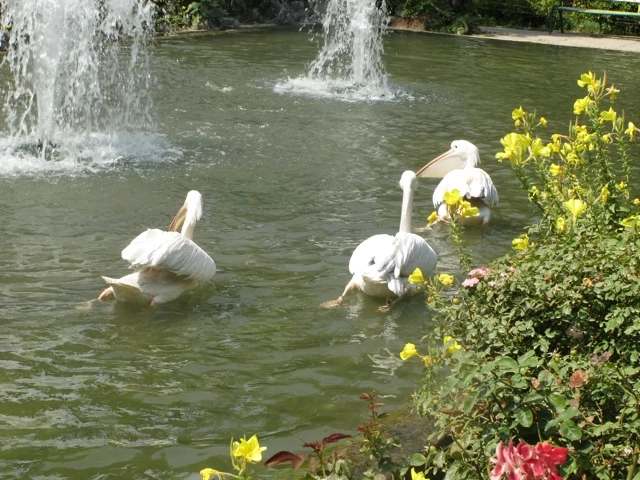
The daily high temperature rose to noon to 54 degrees. It was just too hot for any activity. Under a few palm trees we cooked a delicious lunch and braved the weather. On the way to the bus terminal a strong wind blew. It felt like being blown into the face with the hair dryer at the highest level. Not funny! We were looking forward to the air-conditioned night bus to Mashhad. Unfortunately, our seats were just over the engine and so I sweat on the whole trip. We arrived exhausted the next day in the holiest city of this country. With 3 million inhabitants, it is also the second largest city in Iran. In 817 AD, the holy shrine for the eighth Imam (Imam Reza) was erected here. It is the only Imam who has lived in Iran.
Every year more than 20 million visitors come here to pay respects to Imam Reza. There are 12 imams in total. In Iran, everything focuses mainly on the first Imam, Ali, the third, Hossein and the eighth, Reza. Imam Hossein and 72 of his followers were killed in Karbala (Iraq). Most important, however, is the twelfth Imam, Mahdi, or also known by the name of "Valiasr" (the ruler of our time). It is believed that he lived in a prison below a mosque in Samarra since 874 AD. is held captive. He is believed to one day return to earth with the Prophet Jesus at his side and create a just and peaceful world. Ayatollah Khomeini also received the title of Imam after his death. When people hear people talking about the imam today, they usually mean it. His memorial is in Tehran.
After a long search we found Valis Homestay. There we were able to recover after a week of desert. Steve from England, whom we met in Yazd, was there too, and two hours later, Jon and Michael arrived. The two drove in three months from England to here to Mashhad and want to continue cycling to Hong Kong. With their trip, they hope to raise some money for the charity 'WaterAid' hongkongcycle.co.uk. Actually, we wanted to pick up our visas at the Turkmen Embassy on the same day. For some religious festival, the message was closed. So we realized that we have to pass our time in this city until Monday.
Vali invited us on a mountain tour with him on Sunday. Why not?! So we took the bus to the first mountain village to eat a snack there. Vali's parents grew up in this place. Hitchhiking went on. Again, the locals love to take some pictures of them. Then it was 2500m above sea level, where we had a wonderful view of a remote mountain valley and Vali gave us some information about the region. In the village there was a small sightseeing tour with tea break at a peasant family. Wonderful!
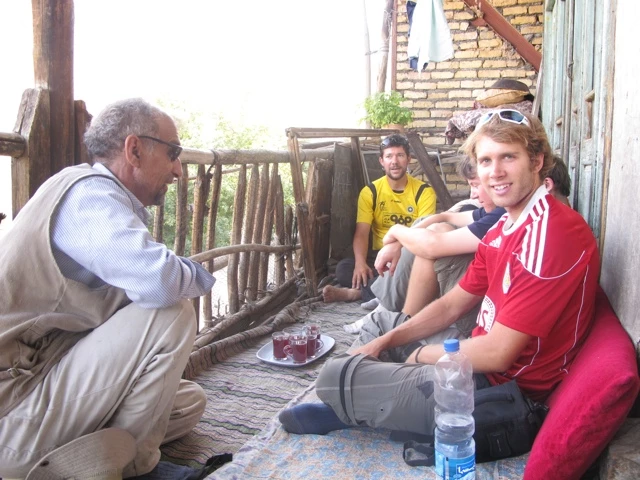
On Monday we tried our luck again at the Turkmen Embassy. At half past eight we were there. Half an hour later, someone from the Embassy appeared and announced that no transit visas will be issued today. Another day in Mashhad.
There we met a Pakistani family who invited us to cay and cake. We spent our last day together with them until late in the evening.
The next morning the others drove on to Turkmenistan. Since I had 20 days left until I was allowed to leave the country (I do not have much practice with scheduling while traveling), I headed northwest to the Caspian Sea. Because my money was running low, I tried as much as possible to spend the night in the tent. I finally found my long desired Persian rug at Bali.

This has greatly improved my quality of life on this journey. Now I can set up a small seat in front of my tent every evening with the thing and put my shoes on it before going to bed. What a luxury! When getting up in the morning I can celebrate my morning ritual. I really enjoyed this little work of art. Already on the second day it went right into the mountains. In the morning, I always get up at 4 o'clock in the morning and then leave at 5 o'clock when the first rays of sunshine arrive. At about 11 o'clock I usually put in a 5-hour lunch break. There is no time for breakfast in the morning. That's why I made a short stop next to a truck 15 kilometers before Bojnurd that day. Hossein, the driver, used to work for the Air Force and spoke pretty good English. He invited me to breakfast in his truck first, and then spent the rest of the day with his family. His son breeds pigeons on the roof of the house and showed me a great air show.
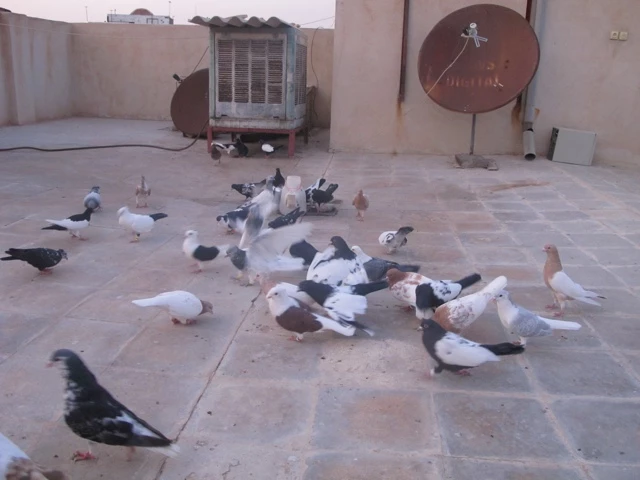

In the evening we went with the whole family to the park for a picnic. The Iranians are probably world champions in this discipline. As soon as dusk comes, they flock to the parks in huge numbers. Ironically, however, this is also one of the few activities that the government allows them to do in public. For me it became increasingly exhausting, as I was already able to experience quite a few of these meals. On one side, it's just unbelievable how hospitable these people are. On the other hand, after 120 kilometers you are usually too tired to talk to people. The Iranians do not eat until about 10 pm and that's why I mostly came to bed late. If you have to get back on your bike after 4 hours of sleep, that's just too tiring over time. After Bojnurd, I decided to spend the rest of my time in Iran in the tent. Also the daily several times small Talk rose slowly to my head. Actually, this is already crazy: One travels alone through world history and suddenly wishes to be left as quiet as possible. After 350 kilometers, the mountain road fell into a large valley. Everything was so green here that I felt a bit like Switzerland.

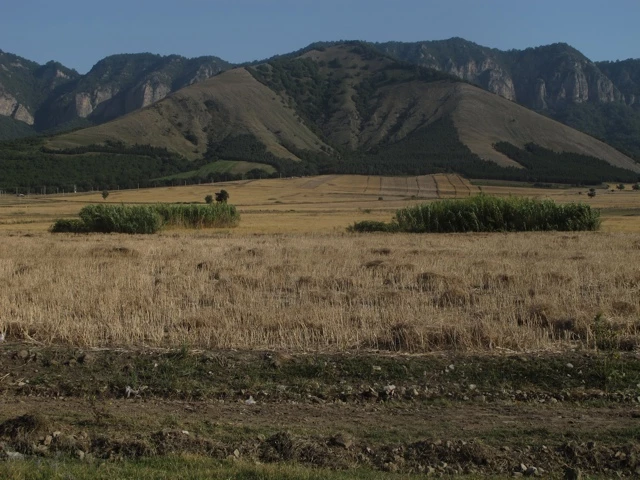
The climate is a lot more pleasant here. Only 40 degrees! Suddenly a cyclist appeared on the horizon. It was Jeremy because I had already met in Yazd. Since we both wanted to cycle away from the heat, we talked only briefly. In the summertime many believers make a pilgrimage to Mashhad. As a result, guarded campsites are available in almost every village in the evening. In Gorgan I decided after 560 kilometers on such a place to take a rest day. Then I wanted to drive a little more in the desert again to visit the wall of Alexander the Great. In Persian it is called Sadd-e Eskander. Alexander the Great wanted to protect his empire by building this wall from attacks from the north. For the Iranian world, it symbolizes the end of civilization. Despite great effort and several interviews with the population I could find no remains. Only big wide desert. After 30 kilometers I met Trudi's friends for the first time.


The camels walked comfortably across the street. On the way, I passed huge herds. They are often among the Turkmen nomads who migrate here in the border area during the summer months. I spent the night in a forest where a thunderstorm really arose during dinner. Gorgeous! I enjoyed every drop that fell from the sky. The next day we went from Assad Shahr in the Alborz Mountains. First came a long green valley with tons of rice fields.

Everything is worked up here in laborious manual work. The road was quite narrow and slowly meandered up the mountains. Unfortunately, there is a lot of traffic here. The truck drivers were extremely aggressive. Why should I learn soon. Several times the police stopped me and did not speak a word of English. After a few unsuccessful attempts to communicate with me on Farsi, they had to let me go again. In the beginning it was still quite funny, but over time it became very tedious and annoying. After 60 kilometers with a 10% gradient, my energy reserves were at rock bottom. Thankfully, they invited me to a cup of Cay. That gave me energy for the remaining 5 kilometers. While drinking, the drivers smoked comfortably their opium, as it would be the most normal thing in the world. I have experienced this many times in Iran. This is also the reason why in Iran I have been increasingly pushed off the road by drivers. The drivers are often drugged. From all my experience, I have to say that due to the many prohibitions and strict police controls, crime is enormous. I can understand the people well. After all, they live here in a huge prison. Everyone is trying to somehow escape to another world.
It was not until 8 pm that I arrived at the top of the pass. At dusk, I found shelter at a gas station. The staff even invited me for dinner. Dead tired, I fell to bed after 130 kilometers and 2500 meters altitude. The next day I drove to Shahrud. The city is on the edge of Dasht-e Kavir desert. Slowly the temperatures rose again. In the morning the weather was still relatively pleasant. At noon then set in each case a violent counter or crosswind. Not funny! One night I was allowed to sleep in a rescue station. The two paramedics invited me for dinner. They both study anesthesia at the university in Tehran. Previously, I drove past the caravansary Miyandasht.

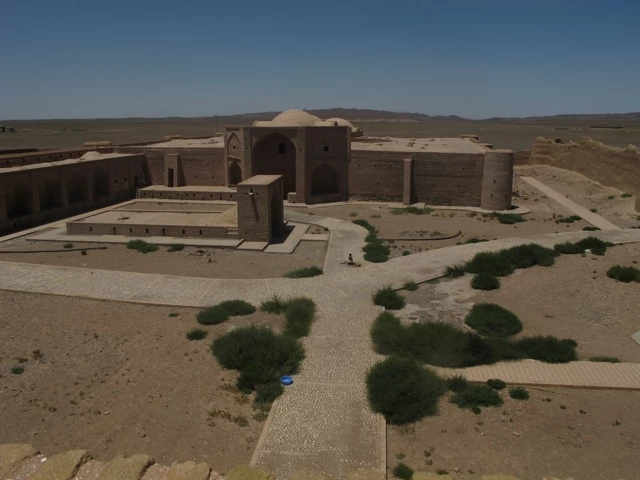
It is one of the best preserved and largest caravanserais in Iran. Overall, it consists of four parts. The western part forms the oldest complex, right next to it is the middle caravansary, which was best preserved. Here the water was stored underground. The government has unfortunately failed to make a Rennovation here. Because of their selfish behavior, they simply ruin many historic buildings. I have seen that throughout the country. A sad thing.
The next morning, when I wanted to pick up my bicycle, which I had hidden behind the ambulance vehicle, my bag was cut open with the food and all contents were gone. That brought me to overflow the barrel. Already for the third time I was already robbed in Iran. I was pretty full and wanted to leave the country on a direct path. Unfortunately, I can only leave on July 28th. In the next few days I tried to avoid people as much as possible and drove through the mountain landscape with a huge fury in my stomach. That helped me a lot. This gave me a tremendous speed and completed nearly 140 kilometers every day. When I wanted to lunch in a park, a family joined me. We first talked to the usual questions: "How are you?", "Where do you come from?", "What's your idea about Iran?" Etc. They had three daughters. Two are already married and the youngest will soon be on the line. With great zeal they tried to offer me this daughter for marriage. It took me a long time to explain to them that I was dead tired and just wanted to sleep at the moment. If all matchmaking goes like this, then I'll never marry! After nearly an hour, they finally drove on to my luck.
On July 18th I was back in Valis Non-Smoking Homestay in Mashhad. Seven days too early. There were now two more German cyclists from Cologne arrived. Herbert is retired and drives as a test driver through the area herbertborn.de.

Phillip met him in Tehran and together they drive to China. The time with them was good for me. So I was able to recover a little from the annoyances and realized that despite all the evil, so far was a great time. Also, the many messages from the home have done me good. Many thanks to all who support me again and again.
Together with them I visited the holy shrine of the 8th Imam Ali ibn Moosa Al-Reza. He was born in Madina in 770 AD and died at the age of 55 as a martyr in Khorassan. For almost twenty years he had been the mentor and leader of the Muslim world. He was burnt right where his shrine stands today. This place is today called Haram-e Razavi. The whole complex can easily compete with the Vatican in Rome. It is a separate city within Mashhad and takes a few hours to visit. Even non-Muslim people are allowed to enter. Only in the center may only Muslim visitors enter. You must not carry any cameras or valuables. However, it is allowed to take pictures with your mobile. Women must wear a chador (long black cloth) and use separate entrances. The dome, as well as all entrances are gilded. Inside, the entire ceiling is covered with mirror mosaics. An impressive sight. In rush hours all places outside the shrine are laid out with prayer rugs. In total, there are four of these courses, each of which is almost twice the size of the Bundesplatz in Bern. The men sit in the front area while the women line up behind them. All doors and gates are touched and kissed. Herbert was admitted to the shrine thanks to his appearance. He told me that the people in it are completely ecstatic and everyone is trying to touch the shrine. His narrative is about it to and fro as in a rugby match. There is not much spirituality left. For me it was a very impressive experience.
Here at Vali meet again and again new people and so there is never boredom. That's a good thing. I do not know how else to kill my last week in Iran. After all, inflation has increased prices so drastically that my budget is pretty much exhausted (currently the current price is 600% above normal). There is simply no smart financial system in Achmadineschad's Wonderland. Luckily Tine and Tim lent me 200 bucks. So I did not have to gnaw on the hunger towel.
Also the vegetarian food of Valis wife was delicious. I would have liked to take her right away. Allegedly the food in Central Asia is a nightmare for vegetarians.
On Thursday, a father arrived here with his son and a friend from Sweden. They travel from their home country by bike to Beijing thebigtrip.se.

Adam from New Zealand arrived here on Saturday. He has been working as a carpenter in London for 5 years and now drives home. We want to cross Turkmenistan together.
The first day in the direction of Sarakhs was initially relatively flat. Around noon, a strong headwind set in. So we siesta under a rock.
By 16:00, the wind had almost built up more. We had a lot of trouble to move forward. In addition, a juicy slope came in between. When it started to get dark stopped us again the police. Fortunately, these could not speak English and let us drive again soon. In a dry riverbed we camped in the middle of the desert. The starry sky was just stunning out here. I've never seen it that intense in my life. Fantastic! The last 85 kilometers to the last city in Iran we covered in half a day. Again, the police annoyed us again: In a park we wanted to make siesta. No sooner had we sat down than the first uniformed man checked the passports. His expression betrayed that he had never seen a visa. He was quite at a loss and of course could not speak English. His colleague was a bit disoriented. When we asked for an internet café, someone picked up his radio, spoke a few words to Farsi, and shortly after, two more policemen stood in front of us. With hands and feet, they indicated that we should follow them with the bikes. We were expecting an afternoon at the police station. However, they took us to the Internet Café and reserved two places for the weird tourists. That's what I call a decent service! If only that had always been the case. Now we are sitting in the overpriced hotel waiting to cross the border.
My Conclusion on Iran: I was overwhelmed with a hospitality that I had never encountered before on my trip. The Iranians are definitely world champions in picnicking and extremely helpful. Unfortunately, I also had some very uncomfortable experiences and the traffic was horrible. This has often clouded my positive image. What the government is allowed in this country is hair-raising and simply incomprehensible. Religion and politics do not belong on the same stage. After 58 days, I'm glad to be able to leave the country and live in freedom again. Thanks to the experience here, I now know how wonderful it can be to grow up in a direct democracy where human rights are respected.
A little note to the end: Since I do not want to endanger any persons, I refrain in all Iran reports to publish pictures of them.